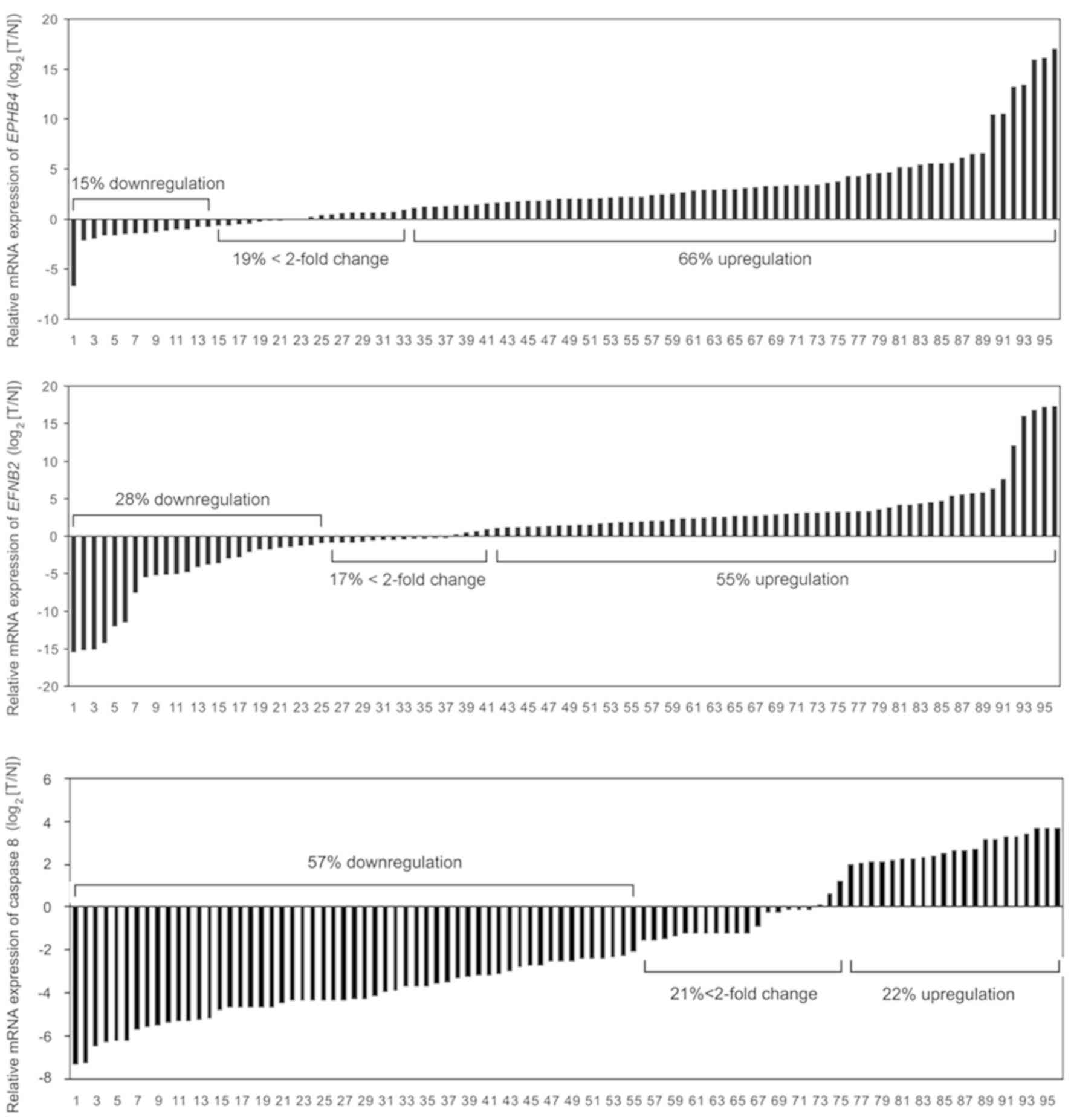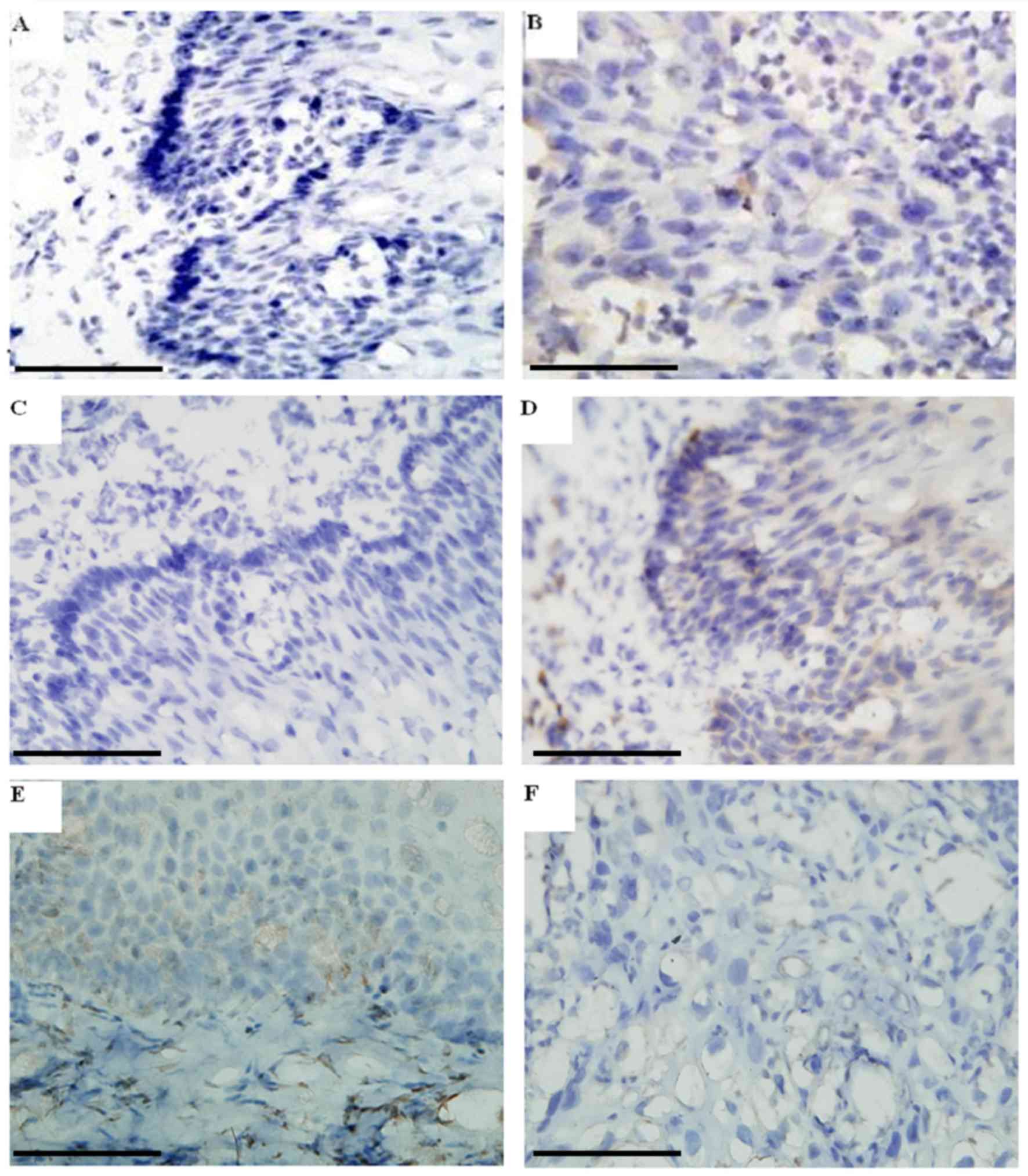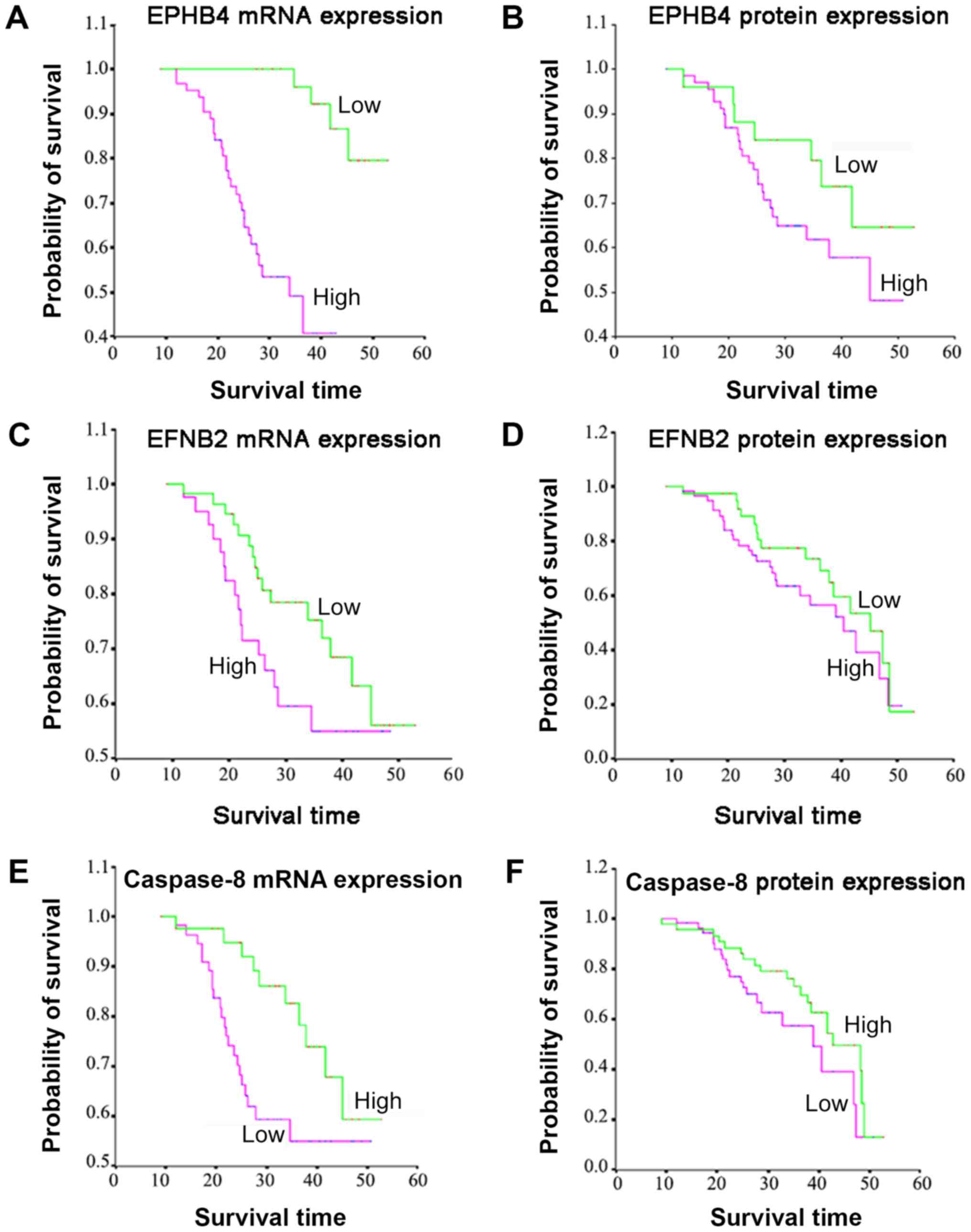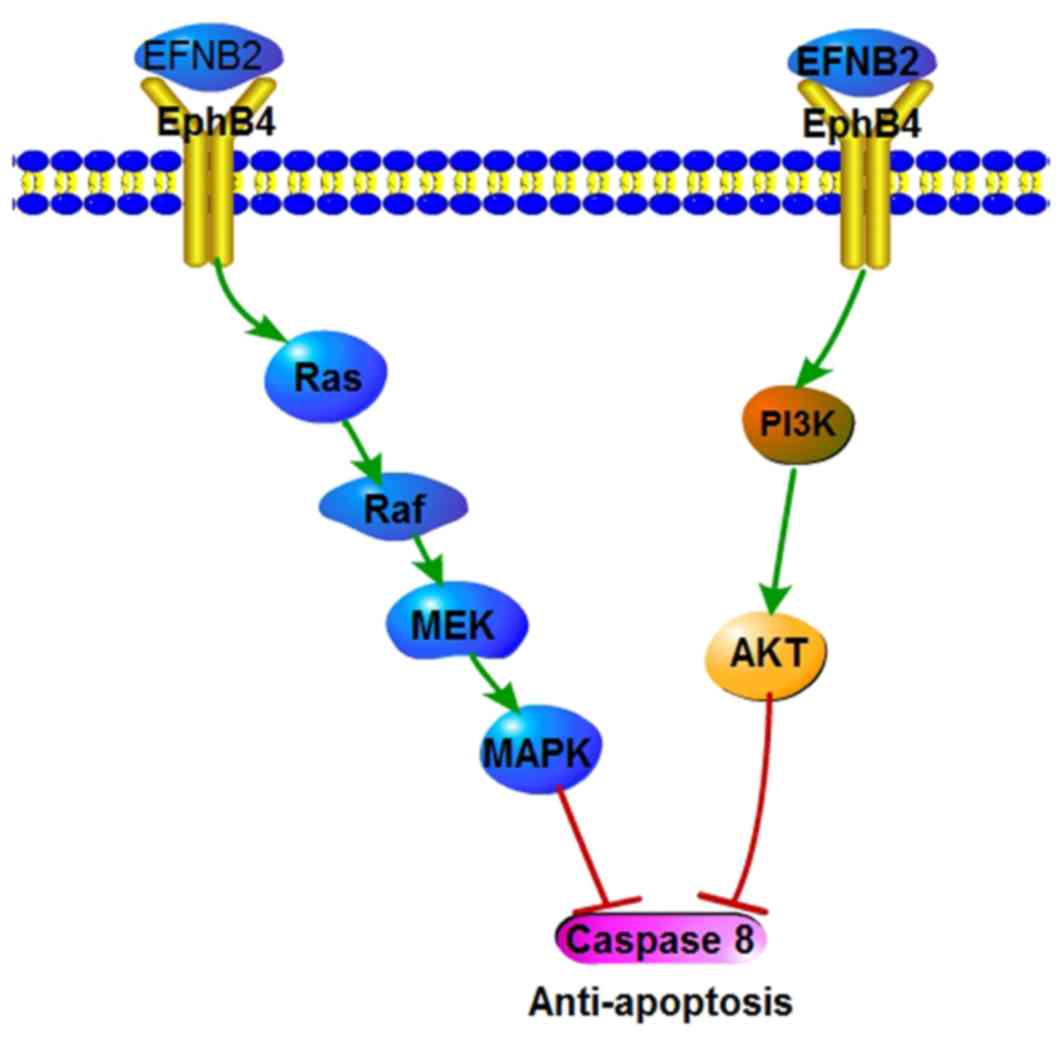|
1
|
Unified nomenclature for Eph family
receptors and their ligands, the ephrins. Eph Nomenclature
Committee. Cell. 90:403–404. 1997. View Article : Google Scholar : PubMed/NCBI
|
|
2
|
Wilkinson DG: Multiple roles of EPH
receptors and ephrins in neural development. Nat Rev Neurosci.
2:155–164. 2001. View
Article : Google Scholar : PubMed/NCBI
|
|
3
|
Palmer A and Klein R: Multiple roles of
ephrins in morphogenesis, neuronal networking, and brain function.
Genes Dev. 17:1429–1450. 2003. View Article : Google Scholar : PubMed/NCBI
|
|
4
|
Heroult M, Schaffner F and Augustin HG:
Eph receptor and ephrin ligand-mediated interactions during
angiogenesis and tumor progression. Exp Cell Res. 312:642–650.
2006. View Article : Google Scholar : PubMed/NCBI
|
|
5
|
Kd gsbrun M and Eichmann A: A role for
axon guidance receptors and ligands in blood vessel development and
tumor angiogenesis. Cytokine Growth Factor Rev. 16:535–548. 2005.
View Article : Google Scholar : PubMed/NCBI
|
|
6
|
Batlle E, Bacani J, Begthel H, Jonkheer S,
Gregorieff A, van de Born M, Malats N, Sancho E, Boon E, Pawson T,
et al: EphB receptor activity suppresses colorectal cancer
progression. Naturec. 435:1126–1130. 2005. View Article : Google Scholar
|
|
7
|
Huusko P, Ponciano-Jackson D, Wolf M,
Kiefer JA, Azorsa DO, Tuzmen S, Weaver D, Robbins C, Moses T,
Allinen M, et al: Nonsense-mediated decay microarray analysis
identifies mutations of EPHB2 in human prostate cancer. Nat Genet.
36:979–983. 2004. View
Article : Google Scholar : PubMed/NCBI
|
|
8
|
Okumura F, Joo-Okumura A, Obara K,
Petersen A, Nishikimi A, Fukui Y, Nakatsukasa K and Kamura T:
Ubiquitin ligase SPSB4 diminishes cell repulsive responses mediated
by EphB2. Mol Biol Cell. 8:3532–3541. 2017. View Article : Google Scholar
|
|
9
|
Teitz T, Lahti JM and Kidd VJ: Aggressive
childhood neuroblastomas do not express caspase-8: An important
component of programmed cell death. J Mol Med (Berlin, Germany).
79:428–436. 2001. View Article : Google Scholar
|
|
10
|
Teng Y, Dong YC, Liu Z, Zou Y, Xie H, Zhao
Y, Su J, Cao F, Jin H and Ren H: DNA methylation-mediated caspase-8
downregulation is associated with anti-apoptotic activity and human
malignant glioma grade. Int J Mol Med. 39:725–733. 2017. View Article : Google Scholar : PubMed/NCBI
|
|
11
|
Zhang Y: Epidemiology of esophageal
cancer. World J Gastroenterol. 19:5598–5606. 2013. View Article : Google Scholar : PubMed/NCBI
|
|
12
|
Siegel RL, Miller KD and Jemal A: Cancer
Statistics, 2017. CA Cancer J Clin. 67:7–30. 2017. View Article : Google Scholar : PubMed/NCBI
|
|
13
|
Domper Arnal MJ, Ferrandez Arenas A and
Lanas Arbeloa A: Esophageal cancer: Risk factors, screening and
endoscopic treatment in Western and Eastern countries. World J
Gastroenterol. 21:7933–7943. 2015. View Article : Google Scholar : PubMed/NCBI
|
|
14
|
Tachibana M, Tonomoto Y, Hyakudomi R,
Hyakudomi M, Hattori S, Ueda S, Kinugasa S and Yoshimura H:
Expression and prognostic significance of EFNB2 and EPHB4 genes in
patients with oesophageal squamous cell carcinoma. Dig Liver Dis.
39:725–732. 2007. View Article : Google Scholar : PubMed/NCBI
|
|
15
|
Rice TW, Ishwaran H, Ferguson MK,
Blackstone EH and Goldstraw P: Cancer of the esophagus and
esophagogastric junction: An eighth edition staging primer. J
Thorac Oncol. 12:36–42. 2017. View Article : Google Scholar : PubMed/NCBI
|
|
16
|
Wang Y, Liu DP, Chen PP, Koeffler HP, Tong
XJ and Xie D: Involvement of IFN regulatory factor (IRF)-1 and
IRF-2 in the formation and progression of human esophageal cancers.
Cancer Res. 67:2535–2543. 2007. View Article : Google Scholar : PubMed/NCBI
|
|
17
|
Hasina R, Mollberg N, Kawada I, Mutreja K,
Kanade G, Yala S, Surati M, Liu R, Li X, Zhou Y, et al: Critical
role for the receptor tyrosine kinase EPHB4 in esophageal cancers.
Cancer Res. 73:184–194. 2013. View Article : Google Scholar : PubMed/NCBI
|
|
18
|
Takikita M, Hu N, Shou JZ, Wang QH, Giffen
C, Taylor PR and Hewitt SM: Biomarkers of apoptosis and survival in
esophageal squamous cell carcinoma. BMC Cancer. 9:3102009.
View Article : Google Scholar : PubMed/NCBI
|
|
19
|
Xue LY, Hu N, Song YM, Zou SM, Shou JZ,
Qian LX, Ren LQ, Lin DM, Tong T, He ZG, et al: Tissue microarray
analysis reveals a tight correlation between protein expression
pattern and progression of esophageal squamous cell carcinoma. BMC
Cancer. 6:2962006. View Article : Google Scholar : PubMed/NCBI
|
|
20
|
Yin J, Cui Y, Li L, Ji J and Jiang WG:
Overexpression of EPHB4 is associated with poor survival of
patients with gastric cancer. Anticancer Res. 37:4489–4497.
2017.PubMed/NCBI
|
|
21
|
Liu W, Ahmad SA, Jung YD, Reinmuth N, Fan
F, Bucana CD and Ellis LM: Coexpression of ephrin-Bs and their
receptors in colon carcinoma. Cancer. 94:934–939. 2002. View Article : Google Scholar : PubMed/NCBI
|
|
22
|
Alam S, Fujimoto J, Jahan I, Sato E and
Tamaya T: Overexpression of ephrinB2 and EPHB4 in tumor advancement
of uterine endometrial cancers. Ann Oncol. 18:485–490. 2007.
View Article : Google Scholar : PubMed/NCBI
|
|
23
|
Takai N, Miyazaki T, Fujisawa K, Nasu K
and Miyakawa I: Expression of receptor tyrosine kinase EPHB4 and
its ligand ephrin-B2 is associated with malignant potential in
endometrial cancer. Oncol Rep. 8:567–573. 2001.PubMed/NCBI
|
|
24
|
Li X, Song C, Huang G, Sun S, Qiao J, Zhao
J, Zhao Z and Li M: The coexpression of EPHB4 and EphrinB2 is
associated with poor prognosis in HER2-positive breast cancer.
OncoTargets Ther. 10:1735–1742. 2017. View Article : Google Scholar
|
|
25
|
Zhang S, Jiang T and Liang M: Expression
of Eph B4 and Ephrin B2 in cervical cancer tissues and
angiogenesis. Int J Gynaecol Obstet. 96:46–47. 2007. View Article : Google Scholar : PubMed/NCBI
|
|
26
|
Kumar SR, Masood R, Spannuth WA, Singh J,
Scehnet J, Kleiber G, Jennings N, Deavers M, Krasnoperov V, Dubeau
L, et al: The receptor tyrosine kinase EphB4 is overexpressed in
ovarian cancer, provides survival signals and predicts poor
outcome. Br J Cancer. 96:1083–1091. 2007. View Article : Google Scholar : PubMed/NCBI
|
|
27
|
Neuber C, Belter B, Meister S, Hofheinz F,
Bergmann R, Pietzsch HJ and Pietzsch J: Overexpression of receptor
tyrosine kinase EPHB4 triggers tumor growth and hypoxia in A375
melanoma xenografts: Insights from multitracer small animal imaging
experiments. Molecules. 23(pii): E4442018. View Article : Google Scholar : PubMed/NCBI
|
|
28
|
Masood R, Kumar SR, Sinha UK, Crowe DL,
Krasnoperov V, Reddy RK, Zozulya S, Singh J, Xia G, Broek D, et al:
EPHB4 provides survival advantage to squamous cell carcinoma of the
head and neck. Int J Cancer. 119:1236–1248. 2006. View Article : Google Scholar : PubMed/NCBI
|
|
29
|
Erber R, Eichelsbacher U, Powajbo V, Korn
T, Djonov V, Lin J, Hammes HP, Grobholz R, Ullrich A and Vajkoczy
P: EphB4 controls blood vascular morphogenesis during postnatal
angiogenesis. EMBO J. 25:628–641. 2006. View Article : Google Scholar : PubMed/NCBI
|
|
30
|
Kertesz N, Krasnoperov V, Reddy R,
Leshanski L, Kumar SR, Zozulya S and Gill PS: The soluble
extracellular domain of EPHB4 (sEphB4) antagonizes EPHB4-EphrinB2
interaction, modulates angiogenesis, and inhibits tumor growth.
Blood. 107:2330–2338. 2006. View Article : Google Scholar : PubMed/NCBI
|
|
31
|
He S, Ding Y, Zhou J, Krasnoperov V,
Zozulya S, Kumar SR, Ryan SJ, Gill PS and Hinton DR: Soluble EPHB4
regulates choroidal endothelial cell function and inhibits
laser-induced choroidal neovascularization. Invest Ophthalmol Vis
Sci. 46:4772–4779. 2005. View Article : Google Scholar : PubMed/NCBI
|
|
32
|
Noren NK, Lu M, Freeman AL, Koolpe M and
Pasquale EB: Interplay between EPHB4 on tumor cells and vascular
ephrin-B2 regulates tumor growth. Proc Natl Acad Sci USA.
101:5583–5588. 2004. View Article : Google Scholar : PubMed/NCBI
|
|
33
|
Folkman J: Angiogenesis in cancer,
vascular, rheumatoid and other disease. Nat Med. 1:27–31. 1995.
View Article : Google Scholar : PubMed/NCBI
|
|
34
|
Bouck N: Angiogenesis: A mechanism by
which oncogenes and tumor suppressor genes regulate tumorigenesis.
Cancer Treat Res. 63:359–371. 1992. View Article : Google Scholar : PubMed/NCBI
|
|
35
|
Steinle JJ, Meininger CJ, Forough R, Wu G,
Wu MH and Granger HJ: Eph B4 receptor signaling mediates
endothelial cell migration and proliferation via the
phosphatidylinositol 3-kinase pathway. J Biol Chem.
277:43830–43835. 2002. View Article : Google Scholar : PubMed/NCBI
|
|
36
|
Yang NY, Pasquale EB, Owen LB and Ethell
IM: The EPHB4 receptor-tyrosine kinase promotes the migration of
melanoma cells through Rho-mediated actin cytoskeleton
reorganization. J Biol Chem. 281:32574–32586. 2006. View Article : Google Scholar : PubMed/NCBI
|
|
37
|
Meyer S, Hafner C, Guba M, Flegel S,
Geissler EK, Becker B, Koehl GE, Orso E, Landthaler M and Vogt T:
Ephrin-B2 overexpression enhances integrin-mediated ECM-attachment
and migration of B16 melanoma cells. Int J Oncol. 27:1197–1206.
2005.PubMed/NCBI
|
|
38
|
Xia G, Kumar SR, Masood R, Koss M,
Templeman C, Quinn D, Zhu S, Reddy R, Krasnoperov V and Gill PS:
Up-regulation of EPHB4 in mesothelioma and its biological
significance. Clin Cancer Res. 11:4305–4315. 2005. View Article : Google Scholar : PubMed/NCBI
|
|
39
|
Xia G, Kumar SR, Masood R, Zhu S, Reddy R,
Krasnoperov V, Quinn DI, Henshall SM, Sutherland RL, Pinski JK, et
al: EPHB4 expression and biological significance in prostate
cancer. Cancer Res. 65:4623–4632. 2005. View Article : Google Scholar : PubMed/NCBI
|
|
40
|
Xia G, Kumar SR, Stein JP, Singh J,
Krasnoperov V, Zhu S, Hassanieh L, Smith DL, Buscarini M, Broek D,
et al: EPHB4 receptor tyrosine kinase is expressed in bladder
cancer and provides signals for cell survival. Oncogene.
25:769–780. 2006. View Article : Google Scholar : PubMed/NCBI
|
|
41
|
Lian H, Jia X, Shi N, Xie S, Wang J, Wang
W, Ma F, Liu H, Wang A, Cheng X and Liu C: Notch signaling promotes
serrated neoplasia pathway in colorectal cancer through epigenetic
modification of EPHB2 and EPHB4. Cancer Manag Res. 10:6129–6141.
2018. View Article : Google Scholar : PubMed/NCBI
|
|
42
|
Lv J, Xia Q, Wang J, Shen Q, Zhang J and
Zhou X: EPHB4 promotes the proliferation, invasion, and
angiogenesis of human colorectal cancer. Exp Mol Pathol.
100:402–408. 2016. View Article : Google Scholar : PubMed/NCBI
|
|
43
|
Wu Q, Suo Z, Kristensen GB, Baekelandt M
and Nesland JM: The prognostic impact of EphB2/B4 expression on
patients with advanced ovarian carcinoma. Gynecol Oncol. 102:15–21.
2006. View Article : Google Scholar : PubMed/NCBI
|
|
44
|
Hanahan D and Weinberg RA: The hallmarks
of cancer. Cell. 100:57–70. 2000. View Article : Google Scholar : PubMed/NCBI
|


















